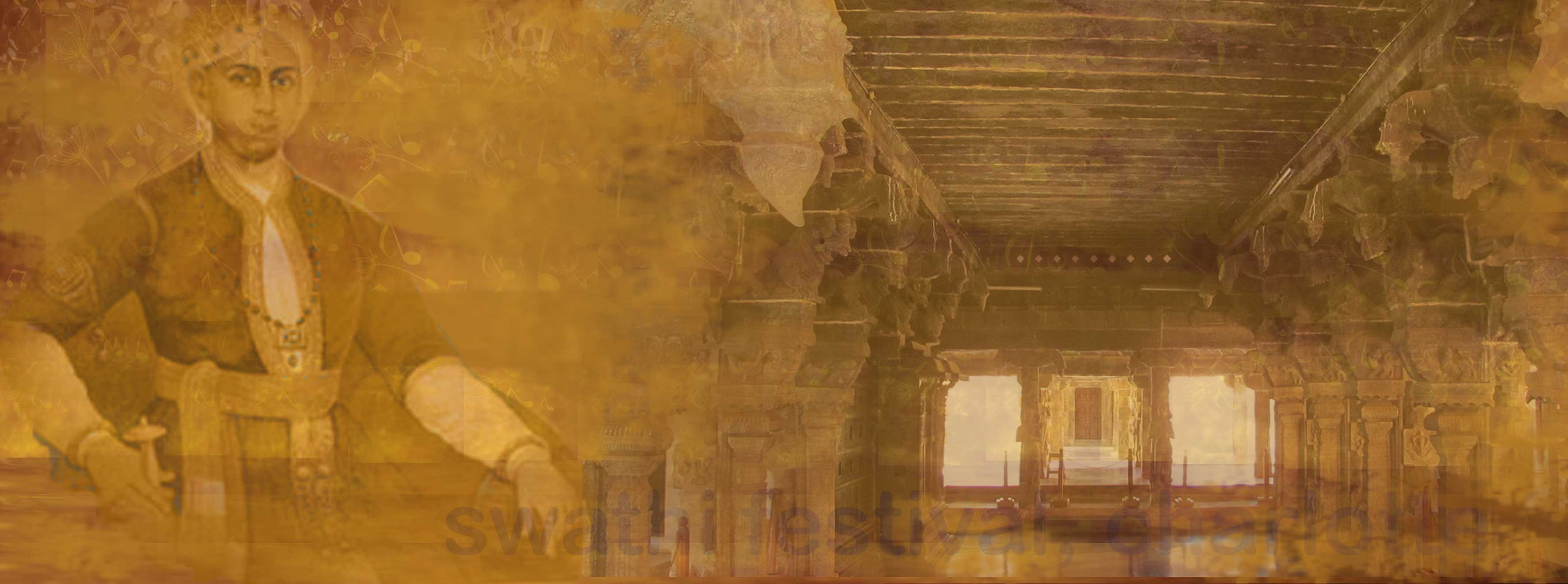Sri Swathi Thirunal Rama Varma was born into the Chera Dynasty of the royal family of Travancore, which is now a part of Kerala, on 16 April 1813. He was born to Rani Gauri Lakshmi Bai of Travancore & Raja Raja Varma Koyi Thampuran, a Samskritam scholar, of Changanasseri Palace. While in the womb itself, he was proclaimed King and was referred to as Garbha Sreeman. The most famous lullaby in Malayalam “Omana thingal kidavo…” was composed by Irayimman Thampi for Swathi Thirunal.
As a young prince, he was trained in several languages, including Malayalam, Kannada, Tamil, Hindustani, Telugu, Marathi, Sanskrit, English and Persian. The extraordinary intellectual exuberance of Swathi Thirunal and the deeper interest and insight he showed in music and literature, amazed his tutors, and the Britishpersonalities who visited the state.
Swathi Thirunal was deeply interested in music right from childhood. Besides being an able ruler, he was a patron of music and was a musician himself. His mudra in compositions are Padmanabha, Sarasijanabha etc. and its synonyms. He is credited with composing over 400 compositions in Carnatic & Hindustani systems. His literary works include Bhakti Manjari, Syanandurapuravarnana Prabandham, Padmanabhasatakam, Muhanaprasa Antyaprasa Vyavastha, Ajamila, Kuchela Upakhyanas & Utsava Varnana Prabandha. He has composed Varnams, Swarajathis, Krithis, Keerthanams, Javalis, Padams and Thillanas in various languages.
He was contemporary to the musical trinity of Carnatic music Thyagaraja (1767-1847), Syama Sastri (1762-1827) and Muthuswami Dikshitar (1775-1835). Many great artists of his time adorned his royal court such as the famous Thanjavur Quartet brothers, Thyagaraja’s disciple Kannaya Bhagavathar, Ananthapadmanabha Goswami, Shadkala Govinda Marar to name a few.
He was also a very efficient administrator and is credited with introduction of English education, construction of an observatory, installation of first Government printing press, establishment of the first manuscripts library etc. for modernizing Travancore.
At the age of 33, Maharajah Swathi Thirunal died on 27 Dec 1846. The award Swathi Sangeetha Puraskaram is instituted in the name of Maharaja to honor those musicians who have made valuable contributions to the field of music. It is the highest honor for musicians by the Government of Kerala, India. Swathi Sangeetha Utsavam, a 10 day music festival featuring exclusively the compositions of Maharaja, is conducted at Kuthira Malika, Thiruvananthapuram from 4th to 13th of January every year by the royal family.
Annual Navarathri Sangeethotsavam is conducted at the Navarathri Mandapam adjacent to Sri Padmanabha Swamy Temple. A Saraswati Vigraham gifted by Sage Kambar (author of Kamba Ramayana) to a Chera King who was his disciple, is worshipped at the Navarathri Mandapam during the festival.
Maharaja Swathi Thirunal composed nine songs in nine ragas for the Navarathri concerts. During the first three days the Devi is worshipped as Saraswathi, as Lakshmi during the next three days and as Durga on the last three days.
The Navarathri Mandapam is situated inside a beautiful wooden building. During the festival it is decorated with fresh flowers and fruits. Oil lamps light the entire place. Sandalwood and camphor are used as incense. It is a rare and divine experience to visit the Navarathri Mandapam and listen to the special concerts. Even today age-old codes of dress and conduct are followed here. Only at the Navarathri Mandapam that it is mandatory to play the mridangam during the rendering of Thanam. Till recently Khatam was not permitted here. Almost all the great singers have sung here.

